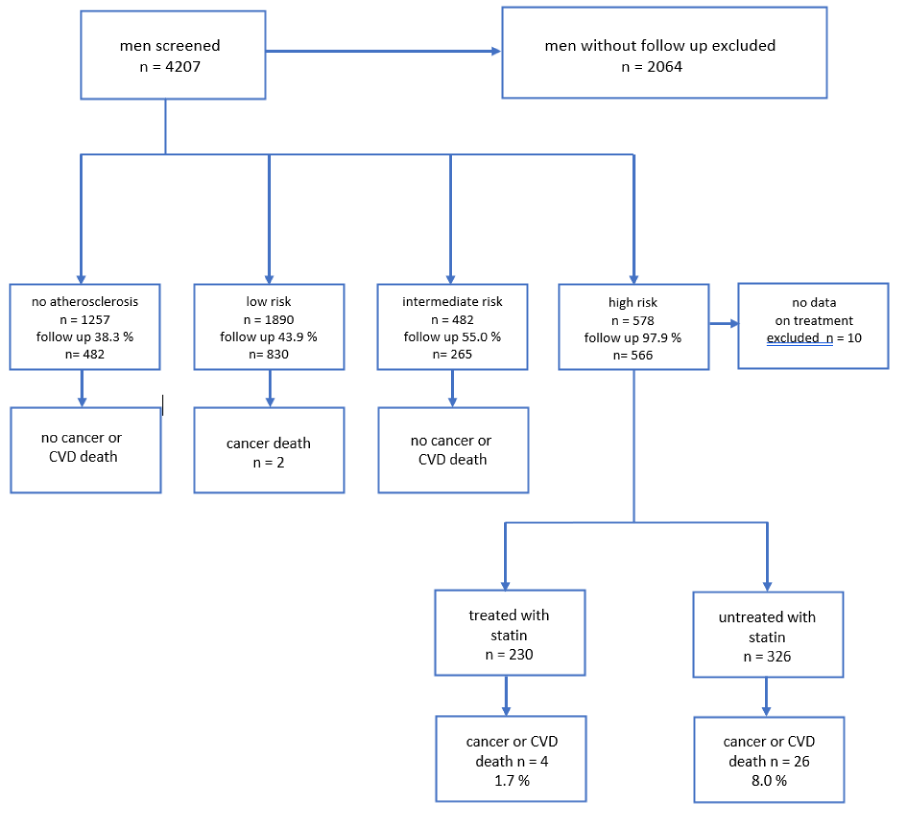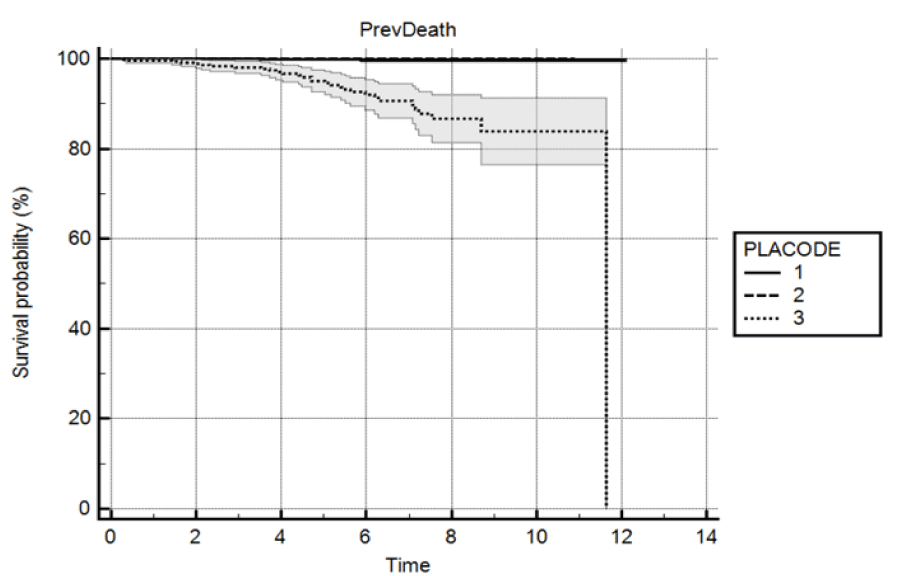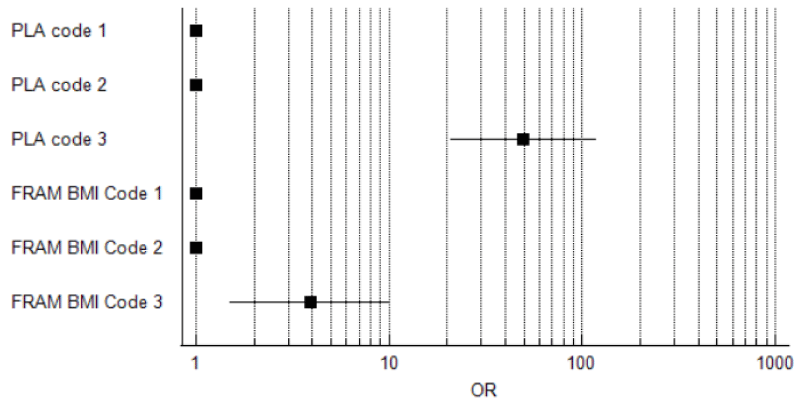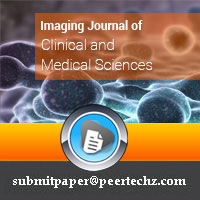Imaging Journal of Clinical and Medical Sciences
Relationship between Atherosclerosis and Cancer: An observational outcome study
Ansgar Adams1*, Waldemar Bojara2 and Michel Romanens3
2Medical Clinic Cardiology Koblenz, Community Clinic Kemperhof II, Koblenz, Germany
3Vascular Risk Foundation (Varifo), Olten, Switzerland
Cite this as
Adams A, Bojara W, Romanens M (2022) Relationship between Atherosclerosis and Cancer: An observational outcome study. Imaging J Clin Medical Sci 9(1): 001-006. DOI: 10.17352/2455-8702.000134Copyright License
© 2022 Adams A, et al. This is an open-access article distributed under the terms of the Creative Commons Attribution License, which permits unrestricted use, distribution, and reproduction in any medium, provided the original author and source are credited.Background and aims: It was investigated whether there is a relationship between advanced atherosclerosis of the carotid artery and cancer.
Method: The carotid Total Plaque Area (TPA), the maximum plaque thickness, and the cardiovascular risk based on Framingham calculator using body-mass-index were determined in healthy subjects using ultrasound.
We compared the outcome in subjects with advanced atherosclerosis of the carotid artery (type III-IV b finding) with and without statin treatment. The follow-up was collected as part of occupational health check-ups.
Result: In 4207 healthy men aged 35-65 years (50±8 years) we found 578 subjects with advanced atherosclerosis of the carotid artery (type III-IV b finding). A follow-up was available for 566 (97.9%) subjects. The average follow-up time was 48 months (range 0 to 139 months). Ten subjects were excluded because of missing data on treatment. A total number of 230 subjects was treated with a statin, 326 received no statin. Within the group of these subjects (54±6 years), 33 men died (15 cancer, 4 strokes, 11 heart attacks, 1 COPD, 1 sepsis, 1 cirrhosis of the liver).
In the group with CVD death, two subjects were treated with a statin, 13 were untreated. In the group with cancer death, two subjects were treated with a statin, 13 were untreated. The death rate because of cancer and CVD was 1.7% for the treated subjects and 8.0% for the untreated subjects.
In the group with low risk (n= 1890), six men died (2 traffic accidents, 1aneurysm bleeding, 2 cancer, 1 unclear, a follow-up examination has been completed for 43.9% (n= 830) of the subjects, mean follow-up time of 65 months (0-137 months). One man died (Parkinson) within the group with intermediate risk. In this group (n= 482) a follow-up examination has been completed for 55% (n= 265) with a mean follow-up time of 55 months (total range: 0-130 months). In the reference group (no atherosclerosis; n= 1257) follow-up has been completed in 38.3% (n= 482) with a mean follow-up time of 60 (0-145) months and nobody died.
In 3203 healthy women aged 35-65 years nobody died of cancer.
Conclusion: The development of cancer in men with advanced atherosclerosis of the carotid artery appears to be noticeable. The question of whether there is a causal relationship requires further investigations.
Abbreviation
TPA: Total Plaque Area (carotid plaque)
Introduction
Atherosclerosis imaging of the carotid artery can improve the risk prediction for cardiovascular disease [1-11] and statin therapy in the subclinical stage improves the prognosis [11-17]. Cancer and atherosclerosis share risk factors such as diabetes, smoking, and obesity. This can be an explanation for the association of increased plaque burden on the carotid artery and cancer [18]. Smoking is an important risk factor for advanced atherosclerosis. In our cohort, the mean TPA in all age groups for smokers is about twice as high as that the one for those who never smoked.
Materials and methods
In 4207 healthy men aged 35-65 years, the Total Plaque Area (TPA), the maximum plaque thickness, and the cardiovascular risk based on Framingham calculator using body-mass-index [19] were determined in an occupational medical setting using ultrasound. The carotid plaque surface was imaged with a high-resolution ultrasound linear transducer probe (10.0MHz). The measuring method was described in earlier publications. Four plaque types were classified, with type I and II a representing low cardiovascular risk, type II b and IV a representing intermediate risk, and type III and IV b representing high risk [7,8]. We defined the following categories based on the TPA and maximum plaque thickness: no measurable atherosclerosis and increasing tertiles for those with atherosclerosis according to the risk stratification [9].
We compared causes of death for subjects with advanced atherosclerosis of the carotid artery (type III-IV b finding) with and without statin treatment. The follow-up was collected as part of occupational health check-ups. The evaluation of all investigations was carried out with the approval of the responsible ethics committee. This study was conducted in compliance with the ethical standards of the responsible institution on human subjects as well as with the Helsinki Declaration. Furthermore, we obtained a follow-up for some subjects without high-risk carotid plaque.
Result
In total, of the 4207 men who were included in the study were 2064 excluded due to missing follow-up data, resulting in several 2143 adults for the final study. Figure 1 presents the results of carotid artery screening with ultrasound.
Type III and IV b atherosclerosis were found in 578 subjects. A follow-up was available for 566 (97.9%) subjects. The average follow-up time was 48 months (range 0 to 139 months). In total, 230 subjects were treated with a statin, 326 received no statin. Ten subjects were excluded because of missing data on treatment. Within the group of these subjects (54±6 years), 33 men died (15 cancer lung, stomach, pancreas, larynx, gallbladder, 4 strokes, 11 heart attacks, 1 COPD, 1 sepsis, 1 cirrhosis of the liver).
In the group with CVD death, two subjects were treated with a statin, 13 were untreated. In the group with cancer death, two subjects were treated with a statin, 13 were untreated. The death rate because of cancer and CVD was 1.7% for the treated group and 8.0% for the untreated group.
In the group with low risk (n = 1890), six men died (2 traffic accidents, 1 aneurysm bleeding, 2 cancer, 1 unclear), a follow-up examination has been completed for 43.9% of the subjects. The average follow-up time was 65 months (range 0 to 137 months). One man died (Parkinson) within the group with intermediate risk. In this group (n= 482) a follow-up examination has been completed for 55% of the subjects. The average follow-up time was 55 months (range 0 to 130 months). In the reference group (no atherosclerosis; n= 1257) follow-up has been completed in 38.3% (n= 482) with a mean follow-up time of 60 (0-145) months and nobody died. In the groups without or low carotid atherosclerosis (Table 1; n= 1577) two men (0.1%) died of cancer. In the group with advanced carotid atherosclerosis (n= 566) 15 men (2.7%) died of cancer.
In the high-risk group, 227 subjects (40.1%) were smokers. In total, 11 (4.8%) smokers died from cancer. In the group with low and intermediate-risk, 376 subjects (23.9%) were smokers. One (0.3%) smoker died from cancer.
Table 1 presents clinical baseline characteristics for men with no carotid plaque (no atherosclerosis) and tertiles of carotid atherosclerosis. Carotid plaque was found in 1661 (77.5%) individuals.
Table 2 presents clinical baseline characteristics for patients with cancer and CVD death. The risk factors for cancer and CVD death are advanced carotid atherosclerosis, age, smoking, diabetes, hypertension.
Figure 2 shows the unadjusted event rates for cancer/CVD death as a function of plaque-type in ultrasound. High risk was observed with type III-IV b in ultrasound P < 0.0001.
Table 3 shows an unadjusted Cox proportional hazards model survival analysis for cancer/CVD death. For the outcome, Type III-IV b in ultrasound and FRAM-BMI were significant predictors.
Figure 3 shows unadjusted HRs for plaque-type and FRAM-BMI. Both plaque-type in ultrasound and FRAM-BMI had strong predictions for cancer/CVD death (endpoint P-value < 0.001).
Table 4 presents the baseline data for men with low and intermediate-risk in ultrasound with and without follow-up. The baseline data are very similar. One can assume that the outcome for cancer and CVD death would be similar.
In 3203 healthy women aged 35-65 years nobody died of cancer.
Discussion
According to research in PubMed and google scholar, there are only a few studies that report a relationship between atherosclerosis and cancer [18,20-28], in this case specifically on colorectal cancer. Kim et al. retrospectively evaluated 4871 subjects who underwent an ultrasound examination of the carotid artery and a colonoscopy. This showed that the presence of plaques on the carotid artery was correlated with an increased risk of high-risk colorectal adenomas [20]. Some publications describe a correlation between common risk factors such as smoking, diabetes, obesity, chronic inflammation, and the development of atherosclerosis and cancer [23-28]. Dobrzycka, et al. found, after a systematic review on statins and colorectal cancer, suggested evidence that statins have a preventive effect both for prevention and for therapy [21]. Smoking is an important risk factor for advanced atherosclerosis. In our cohort, the mean TPA in all age groups for smokers is about twice as high as the one for those who never smoked. In the reference, low and intermediate-risk group (low atherosclerosis) there are 376 smokers with follow-up. One of whom died of cancer. In the group with advanced atherosclerosis, 15 died of cancer, eleven of whom were smokers. It appears that smoking combined with advanced atherosclerosis is associated with a high risk of cardiovascular and cancer death, but smoking with low atherosclerosis may not. Whether there really is a relationship should be further investigated by appropriate investigations.
It is also noticeable that in the group with advanced atherosclerosis treated with a statin only two subjects died of cancer, while in the untreated group 13 subjects died of cancer. Statin treatment for advanced atherosclerosis can reduce cardiovascular events [13]. Whether this also applies to cancer cannot be deduced from this observational study, hence further investigation seems reasonable. Carotid screening of cancer patients would be useful in this context. A new approach to the prevention of the leading causes of death could emerge.
Conclusion
The development of cancer for men with advanced atherosclerosis of the carotid artery appears noticeable. Whether there is a causal relationship requires further investigation.
There is an initial suspicion that statins could have a preventive effect.
Limitations
The sample size of the study is too small, the outcome events were too few, and the follow-up time was not long enough. All this greatly limit the reliability of the conclusions. Therefore, only a reasonable suspicion can be formulated.
A new analysis should be carried out after a longer follow-up period.
Informed consent
All patients provided informed consent.
Author contributions
WB and MR discussed the approach and the findings of this study with AA intensively and gave AA valuable feedback.
MR supported the statistics.
All examinations have been done by AA.
Data availability
Any inquiries regarding supporting data availability of this study should be directed to the corresponding author.
- Belcaro G, Nicolaides AN, Ramaswami G, Cesarone MR, De Sanctis M, et al. (2001) Carotid and femoral ultrasound morphology screening and cardiovascular events in low risk subjects: a 10-year follow-up study (the CAFES-CAVE study. Atherosclerosis 156: 379-387. Link: https://bit.ly/3un92LB
- Johnsen SH, Mathiesen EB, Joakimsen O, Stensland E, Wilsgaard T, et al. (2007) Carotid atherosclerosis is a stronger predictor of myocardial infarction in women than in men: a 6-year follow-up study of 6226 persons: the Tromso Study. Stroke 38: 2873-2880. Link: https://bit.ly/3Nh4krz
- Mathiesen EB, Johnsen SH, Wilsgaard T, Bonaa KH, Lochen ML, et al. (2011) Carotid plaque area and intima- media thickness in prediction of first-ever ischemic stroke: a 10-year follow-up of 6584 men and women: the Tromso Study. Stroke 42: 972-978. Link: https://bit.ly/3iBVer2
- Inaba Y, Chen JA, Bergmann SR (2012) Carotid plaque, compared with carotid intima-media thickness, more accurately predicts coronary artery disease events: a metaanalysis. Atherosclerosis 220: 128-133. Link: https://bit.ly/36K1KJF
- Rundek T, Arif H, Boden-Albala B, Elkind MS, Paik MC, et al. (2008) Carotid plaque, a subclinical precursor of vascular events: the Northern Manhattan Study. Neurol 70: 1200-1207. Link: https://bit.ly/3ukPXKd
- Baber U, Mehran R, Sartori S, Schoos MM, Sillesen H, et al. (2015) Prevalence, impact, and predictive value of detecting subclinical coronary and carotid atherosclerosis in asymptomatic adults: the BioImage study. J Am Coll Cardiol 65: 1065-1074. Link: https://bit.ly/3L9s7rt
- Adams A, Bojara W (2015) Prediction of coronary artery stenosis by measurement of total plaque area and thickness versus intima media thickness of the carotid artery. Herz 40: 817-822. Link: https://bit.ly/3wCAfwC
- Adams A, Bojara W, Schunk K (2018) Early Diagnosis and Treatment of Coronary Heart Disease in Asymptomatic Subjects With Advanced Vascular Atherosclerosis of the Carotid Artery (Type III and IV b Findings Using Ultrasound) and Risk Factors. Cardiol Res 9: 22-27. Link: https://bit.ly/3L6TfHG
- Adams A, Bojara W, Romanens M (2020) The Determination of the Plaque Burden on the Carotid Artery With Ultrasound Significantly Improves the Risk Prediction in Middle-Aged Subjects Compared to PROCAM: An Outcome Study. Cardiol Res 11: 233-238. Link: https://bit.ly/3qx46To
- Romanens M, Adams A, Sudano I, Bojara W, Balint S, et al. (2021) Prediction of cardiovascular events with traditional risk equations and total plaque area of carotid atherosclerosis: The Arteris Cardiovascular Outcome (ARCO) cohort study. Prev Med 147: 106525. Link: https://bit.ly/3wFJPPc
- Spence JD, Eliasziw M, DiCicco M, Hackam DG, Galil R, et al. (2002) Carotid plaque area: a tool for targeting and evaluating vascular preventive therapy. Stroke 33: 2916-2922. Link: https://bit.ly/3JOu5Ny
- Adams A, Bojara W, Romanens M (2021) Effect of Statin Treatment in Patients With Advanced Carotid Atherosclerosis: An Observational Outcome Study. Cardiol Res 12: 335-339. Link: https://bit.ly/3qvSVKu
- Spence JD, Hackam DG (2010) Treating Arteries Instead of Risk Factors. A Paradigm Change in Management of Atherosclerosis. Stroke 41: 1193-1199. Link: https://bit.ly/3uHZJX5
- Korcarz CE, DeCara JM, Hirsch AT, Mohler ER, Pogue B, et al. (2008) Ultrasound detection of increased carotid intima-media thickness and carotid plaque in an office practice setting: does it affect physician behavior or patient motivation? J Am Soc Echocardiogr 21: 1156-1162. Link: https://bit.ly/3Lc7pXW
- Naslund U, Ng N, Lundgren A, Eva F, Christer G, et al. (2019) Visualization of asymptomatic atherosclerotic disease for optimum cardiovascular prevention (VIPVIZA): a pragmatic, open-label, randomised controlled trial. Lancet 393: 133-142. Link: https://bit.ly/3uoj3Ix
- Spence JD, Coates V, Li H, Tamayo A, Muñoz C, et al. (2010) Effects of Intensive medical therapy on microemboli and cardiovascular risk in asymptomatic carotid stenosis. Arch Neurol 67:180-186. Link: https://bit.ly/36mO0ox
- Spence JD (2020) Stroke Prevention: A Lifetime of Lessons. Stroke 51: 2255-2262. Link: https://bit.ly/36pOpGD
- Nehme F (2020) An Intimal Relationship Between Atherosclerosis and Colorectal Cancer Screening. Dig Dis Sci 65: 1588-1589. Link: https://bit.ly/3JAx10n
- D’Agostino RB., Vasan RS, Pencina MJ, Wolf PA, Cobain M, et al. (2008) General cardiovascular risk profile for use in primary care: the Framingham Heart Study. Circulation 117: 743-753. Link: https://bit.ly/3IzKofZ
- Kim J, Lee JY, Ham NS, Oh EH, Chang HS, et al. (2020) Association Between Carotid Ultrasonography Findings and Colorectal Adenoma in Asymptomatic Adults. Dig Dis Sci 65: 1816-1828. Link: https://bit.ly/3D4j3S1
- Dobrzycka M, Spychalski P, Łachiński AJ, Kobiela P, Jędrusik P, et al. (2020) Statins and colorectal cancer–a systematic review. Exp Clin Endocrinol Diabetes 128: 255-262. Link: https://bit.ly/3Lc7b32
- Whitlock MC, Yeboah J, Burke GL, Chen H, Klepin HD, et al. (2015) Cancer and Its Association With the Development of Coronary Artery Calcification: An Assessment From the Multi-Ethnic Study of Atherosclerosis. J Am Heart Assoc 4: e002533. Link: https://bit.ly/3L58kcA
- Ramos KS, Partridge CR (2005) Atherosclerosis and cancer: Flip sides of the neoplastic response in mammalian cells? Cardiovascular toxicology 5: 245-255. Link: https://bit.ly/3urwMyc
- Morganti M, Carpi A, Nicolini A, Gorini I, Glaviano B, et al. (2002) Atherosclerosis and cancer: common pathways on the vascular endothelium. Biomed Pharmacother 56: 317-324. Link: https://bit.ly/3NkQu7p
- Raposeiras Roubín S, Cordero A (2019) The Two-way Relationship Between Cancer and Atherosclerosis. Rev Esp Cardiol (Engl Ed). 72: 487-494. Link: https://bit.ly/3JOtTxO
- Ross JS, Stagliano NE, Donovan MJ, Breitbart RE, Ginsburg GS (2001) Atherosclerosis: a cancer of the blood vessels?. Pathology Patterns Reviews 116: S97-S107. Link: https://bit.ly/3IuSbeY
- Ross JS, Stagliano NE, Donovan MJ, Breitbart RE, Ginsburg GS (2001) Atherosclerosis and cancer: common molecular pathways of disease development and progression. Ann N Y Acad Sci 947: 271-293. Link: https://bit.ly/3iyBLI0
- Tapia-Vieyra JV, Delgado-Coello B, Mas-Oliva J (2017) Atherosclerosis and cancer; a resemblance with far-reaching implications. Arch Med Res 48: 12-26. Link: https://bit.ly/37XqY8c
Article Alerts
Subscribe to our articles alerts and stay tuned.
 This work is licensed under a Creative Commons Attribution 4.0 International License.
This work is licensed under a Creative Commons Attribution 4.0 International License.




 Save to Mendeley
Save to Mendeley
